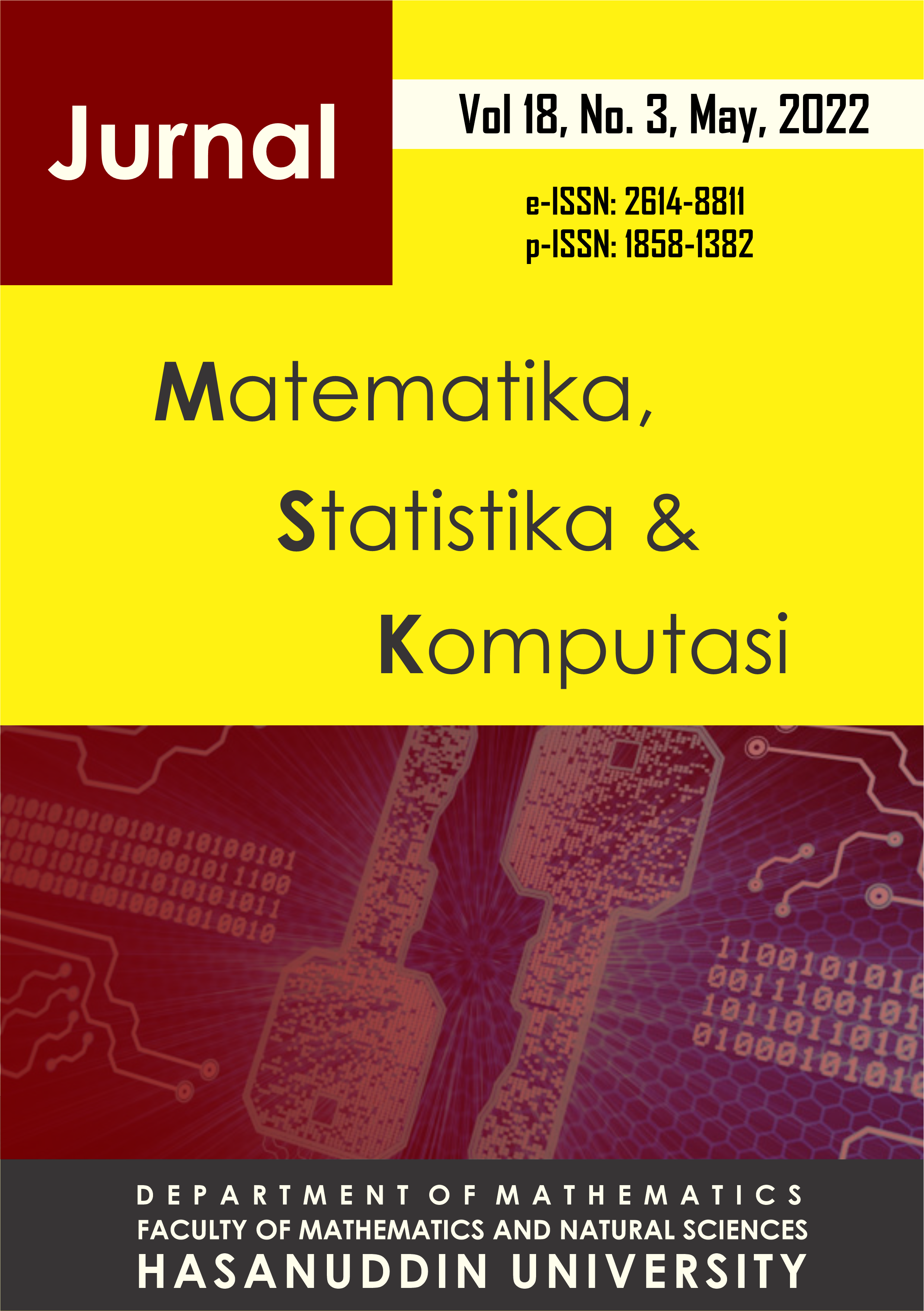Dynamics Analysis of Predator-Prey Model with Double Allee Effects and Holling Type II Functional Response
DOI:
https://doi.org/10.20956/j.v18i3.19237Keywords:
Predator-Prey, Double Allee Effect, Functional Response, Holling Type IIAbstract
In this article, a predator prey model with double Allee effects and Holling type II functional response is discussed. Strong and weak Allee effects were analyzed separately. The dynamic behavior of the model is analyzed by determining the equilibrium point and stability around the equilibrium point. From the analysis result, it is obtained that the trivial equilibrium point is locally asymptotically stable for the case of the strong Allee effect and the saddle unstable for the case of the weak Allee effect, while the boundary and coexistence equilibrium points are locally asymptotically stable if it satisfies several parameter conditions. Numerical simulations are carried out around the coexistence equilibrium point. The simulation results show that the Allee effect threshold affects prey population growth when experiencing a strong Allee effect. The growth of the prey population also depends on the initial conditions of the prey and predator population density. Furthermore, when the prey population experiences a weak Allee effect, there is no threshold must be exceeded for the population to survive so that for each initial condition however, the population will not experience extinction.Downloads
References
Allee, W. C., 1931. Animal Aggregations. A Study in General Sociology. Chicago, University of Chicago Press.
Barclay, H. & Mackauer, M., 1980. The Sterile Insect Release Method for Pest Control: A Density-Dependent Model. Environmental Entomology, 9: 810-817.
Berec, L., Angulo, E. & Courchamp, F., 2007. Multiple Allee Effects and Population Management. Trends in Ecology and Evolution, Vol. 22, No. 4, 185-191.
Courchamp, F., Berec, L. & Gascoigne, J., 2009. Allee Effects in Ecology and Conservation. New York, Oxford University Press.
Courchamp, F., Clutton-Brock, T. & Grenfell, B., 1999. Inverse Density Dependence and the Allee Effect. Trends in Ecology and Evolution, Vol. 14, 405-410.
Dennis, B., 1989. Allee Effects: Population Growth, Critical Density, and the Chance of Extinction. Natural Resource Modeling, Vol. 3, No. 4, 481-538.
Gonzalez-Olivares, E., dkk., 2011. Consequences of Double Allee Effect on the Number if Limit Cycle in a Predator-Prey Model. Computers and Mathematics with Applications, 62: 3449-3463.
Holling, C. S., 1959. Some Characteristics of Simple Types of Predation and Parasitism. The Canadian Entomologist. Vol. 91, No. 7, 385-398.
Kuussaari, M., Saccheri, I., Camara, M. & Hanski, I., 1998. Allee Effect and Population Dynamics in the Glanvillee Fritillary Butterfly. Oikos, 82: 384-392.
Liu, X. & Dai, B., 2017. Dynamics of a Predator-Prey Model with Double Allee Effects and Impulse. Nonlinear Dyn, 88: 685-701.
Pal, P. J. & Saha, T., 2015. Qualitative Analysis of a Predator-Prey System with Double Allee Effect in Prey. Chaos, Solitons & Fractals, Vol. 73, 36-63.
Panigoro, H. S. & Rahmi, E., 2018. Model Leslie-Gower dengan Efek Allee Aditif: Gangguan Periodik pada Pemanenan Proposional terhadap Predator. Prosiding Konferensi Nasional Matematika (KNM), Universitas Brawijaya Malang, 24-26 Juli 2018, hal. 419-426.
Pribylova, L. & Peniaskova, A., 2017. Foraging Facilitation among Predators and Its Impact on The Stability of Predator-Prey Dynamics. Ecological Complexity, Vol. 29, 30-39.
Singh, M. K., Bhadauria, B. S. & Singh, B.K., 2018. Bifurction analysis of modified Leslie-Gower predator-prey model with double Allee effect. Ain Shams Engineering Journal, Vol. 9, No. 4, 1263-1277.
Stephens, P. A. & Sutherland, W. J., 1999. Consequences of the Allee Effect for Behaviour, Ecology and Conservation. Trends in Ecology and Evolution, Vol. 14, No. 10, 401-405.
Taylor, C. M. & Hastings, A., 2005. Allee Effects in Biological Invasions. Ecology Letters, 8: 895-908.
Tian, X. & Xu, R., 2011. Global Dynamics of a Predator-Prey System with Holling Type II Functional Response. Nonlinear Analysis: Modelling and Control, Vol. 16, No. 2, 242-253.
Wang, L. & Xu, R., 2013. Global Dynamics of a Predator-Prey Model with Stage Structure and Delayed Predator Response. Discrete Dynamics in Nature and Society, Vol. 2013, 1-10.
Wang, M. & Kot, M., 2001. Speed of Invasion in a Model with Strong or Weak Allee Effects. Mathematical Biosciences, 171: 83-97.
Yusrianto, Toaha, S. & Kasbawati, 2019. Analisis Kestabilan Model Mangsa Pemangsa dengan Pemanenan Ambang Batas pada Populasi Pemangsa. Jurnal Matematika, Statistika & Komputasi, Vol. 16, No. 1, 97-106.
Downloads
Published
How to Cite
Issue
Section
License
Copyright (c) 2022 Author and publisher

This work is licensed under a Creative Commons Attribution 4.0 International License.

This work is licensed under a Creative Commons Attribution 4.0 International License.
Jurnal Matematika, Statistika dan Komputasi is an Open Access journal, all articles are distributed under the terms of the Creative Commons Attribution License, allowing third parties to copy and redistribute the material in any medium or format, transform, and build upon the material, provided the original work is properly cited and states its license. This license allows authors and readers to use all articles, data sets, graphics and appendices in data mining applications, search engines, web sites, blogs and other platforms by providing appropriate reference.








